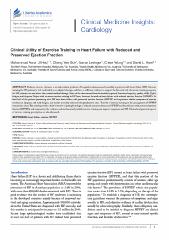Please use this identifier to cite or link to this item:
https://ahro.austin.org.au/austinjspui/handle/1/12641Full metadata record
| DC Field | Value | Language |
|---|---|---|
| dc.contributor.author | Asrar Ul Haq, Muhammad | - |
| dc.contributor.author | Goh, Cheng Yee | - |
| dc.contributor.author | Levinger, Itamar | - |
| dc.contributor.author | Wong, Chiew | - |
| dc.contributor.author | Hare, David L | - |
| dc.date.accessioned | 2015-05-16T02:22:02Z | |
| dc.date.available | 2015-05-16T02:22:02Z | |
| dc.date.issued | 2015-02-09 | en |
| dc.identifier.citation | Clinical Medicine Insights. Cardiology 2015; 9(): 1-9 | en |
| dc.identifier.govdoc | 25698883 | en |
| dc.identifier.other | PUBMED | en |
| dc.identifier.uri | https://ahro.austin.org.au/austinjspui/handle/1/12641 | en |
| dc.description.abstract | Reduced exercise tolerance is an independent predictor of hospital readmission and mortality in patients with heart failure (HF). Exercise training for HF patients is well established as an adjunct therapy, and there is sufficient evidence to support the favorable role of exercise training programs for HF patients over and above the optimal medical therapy. Some of the documented benefits include improved functional capacity, quality of life (QoL), fatigue, and dyspnea. Major trials to assess exercise training in HF have, however, focused on heart failure with reduced ejection fraction (HFREF). At least half of the patients presenting with HF have heart failure with preserved ejection fraction (HFPEF) and experience similar symptoms of exercise intolerance, dyspnea, and early fatigue, and similar mortality risk and rehospitalization rates. The role of exercise training in the management of HFPEF remains less clear. This article provides a brief overview of pathophysiology of reduced exercise tolerance in HFREF and heart failure with preserved ejection fraction (HFPEF), and summarizes the evidence and mechanisms by which exercise training can improve symptoms and HF. Clinical and practical aspects of exercise training prescription are also discussed. | en |
| dc.language.iso | en | en |
| dc.subject.other | HFPEF | en |
| dc.subject.other | exercise | en |
| dc.subject.other | heart failure | en |
| dc.title | Clinical utility of exercise training in heart failure with reduced and preserved ejection fraction. | en |
| dc.type | Journal Article | en |
| dc.identifier.journaltitle | Clinical Medicine Insights. Cardiology | en |
| dc.identifier.affiliation | Austin Health, Heidelberg, Victoria, Australia, Australia | en |
| dc.identifier.affiliation | Institute of Sport, Exercise and Active Living (ISEAL), College of Sport and Exercise Science, Victoria University, Melbourne, Australia | en |
| dc.identifier.affiliation | Northern Heart, The Northern Hospital, Melbourne, Victoria, Australia | en |
| dc.identifier.affiliation | ; University of Melbourne, Melbourne, Victoria, Australia | en |
| dc.identifier.affiliation | ; Austin Health, Heidelberg, Victoria, Australia, Australia | en |
| dc.identifier.doi | 10.4137/CMC.S21372 | en |
| dc.description.pages | 1-9 | en |
| dc.identifier.orcid | 0000-0001-9554-6556 | - |
| dc.identifier.pubmedid | 25698883 | - |
| dc.type.austin | Journal Article | en |
| local.name.researcher | Hare, David L | |
| item.languageiso639-1 | en | - |
| item.fulltext | With Fulltext | - |
| item.cerifentitytype | Publications | - |
| item.openairecristype | http://purl.org/coar/resource_type/c_18cf | - |
| item.openairetype | Journal Article | - |
| item.grantfulltext | open | - |
| crisitem.author.dept | Cardiology | - |
| crisitem.author.dept | Cardiology | - |
| Appears in Collections: | Journal articles | |
Files in This Item:
| File | Description | Size | Format | |
|---|---|---|---|---|
| 25698883.pdf | 471.57 kB | Adobe PDF |  View/Open |
Page view(s)
142
checked on Feb 10, 2025
Download(s)
110
checked on Feb 10, 2025
Google ScholarTM
Check
Items in AHRO are protected by copyright, with all rights reserved, unless otherwise indicated.
